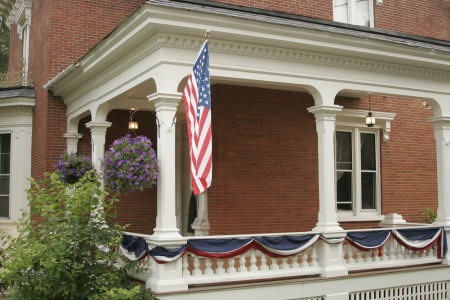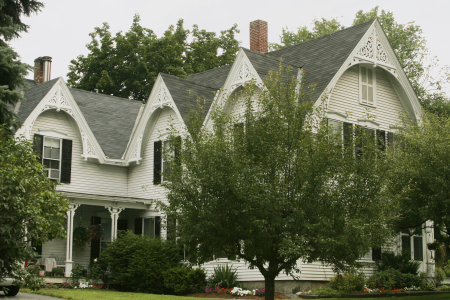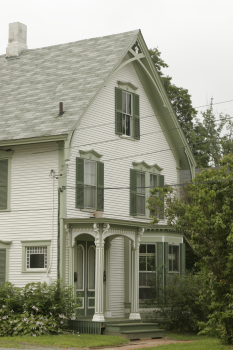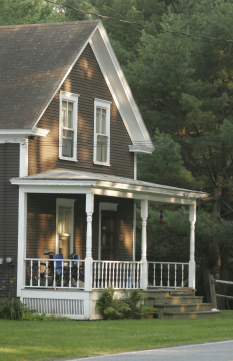 |
| Patriotic, small-town inn. Quechee Village, VT. |
 |
| House with fancy gingerbreading. Lebanon, NH. |
Lebanon is classic New England, with a town square, Congregational Church with spire, and a bunch of 100 year-old houses in a handful of streets near the square. Vermont is a bit more picturesque, partly due to different geography marked by the Connecticut River, and partly just style. The combination of New Hampshire and Vermont gives a classic small-town America feel. The inn with Fourth-of-July bunting shown on the left, the band playing on Monday evening in the bandstand on the square, the long oval in the middle of Woodstock, VT, the family eating dinner on the back porch next to the covered bridge, all combine to give a quiet, homey feel to the area. You can almost hear the Wells Fargo wagon just a-coming’ down the street and children wondering what it has for me.1
I grew up in a small town, Hiram, in an area of Ohio that had the same small-town America feel. Hiram had the same Victorian-era houses, a small liberal arts college, a lot of greenery, and not much else; it was about what you would get if you took Hanover and shrunk it down to a population of 1000 and renamed it Hiram (Hiram College likes to pretend it is like Dartmouth, and looks uncannily similar), so the area felt very familiar. Since I lost all my pictures of Hiram in the untimely demise of a hard drive, I wanted to capture the flavor of the Victorian-era houses that I loved in my youth.
Victorian-era houses are typified, in my mind at least, by large size, some type of gingerbreading on the eaves, a quiet front porch, and a distinct, usually white, long wood siding. They feel like a house that you might have had a servant or two and a parlor with furniture that Sherlock Holmes might have used. These houses are the statesmen of the town, more inviting than the modern home where the garage is the first thing you see, but inviting in a dignified manner. These houses have seen the passing fads (and like a statesman, are a little behind the times themselves), but have provided their occupants a dignified, comfortable, happy home for years.
 |
| Classic small-town house. Lebanon, NH. |
There is always some huge house in these small towns. My friend Jim lived across the street from me in a huge house that used to be a boarding house. Tenants would live in rooms on the second floor and the landlady would provide evening meals. (No such amenities for modern tenants.) The look of the house on the right suggests that it was built with the same intention. It has the fanciest gingerbreading that I have ever seen and illustrates the stark gables that houses of this era tended to have. As it so happens, the most photogenic view is 90 degrees to the right, where the power cables do indeed cross the view, but that direction does not illustrate the gingerbreading nearly so effectively.
The brown house on the bottom illustrates a later type of house that is also common to small towns. This style is much simpler than the Victorian style. Gone is the gingerbreading and ornate column headers. The tops of the windows are flat and even the shutters are gone. The porch columns have become round. It is difficult to see in this image, but these posts retain a certain ornateness in the grooves turned into the top and bottom of the round parts. There is a power line hidden at the top and some phone lines crossing the center of the image.
 |
| Later small-town
house. Quechee Village, VT. |
1 From the musical The Music Man, Meredith Willson.